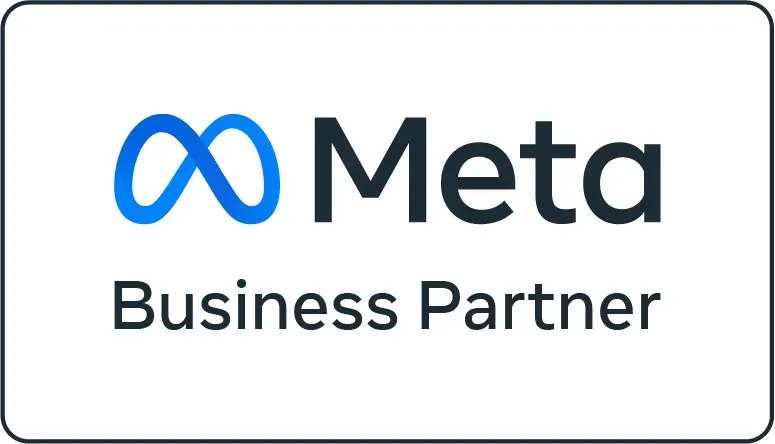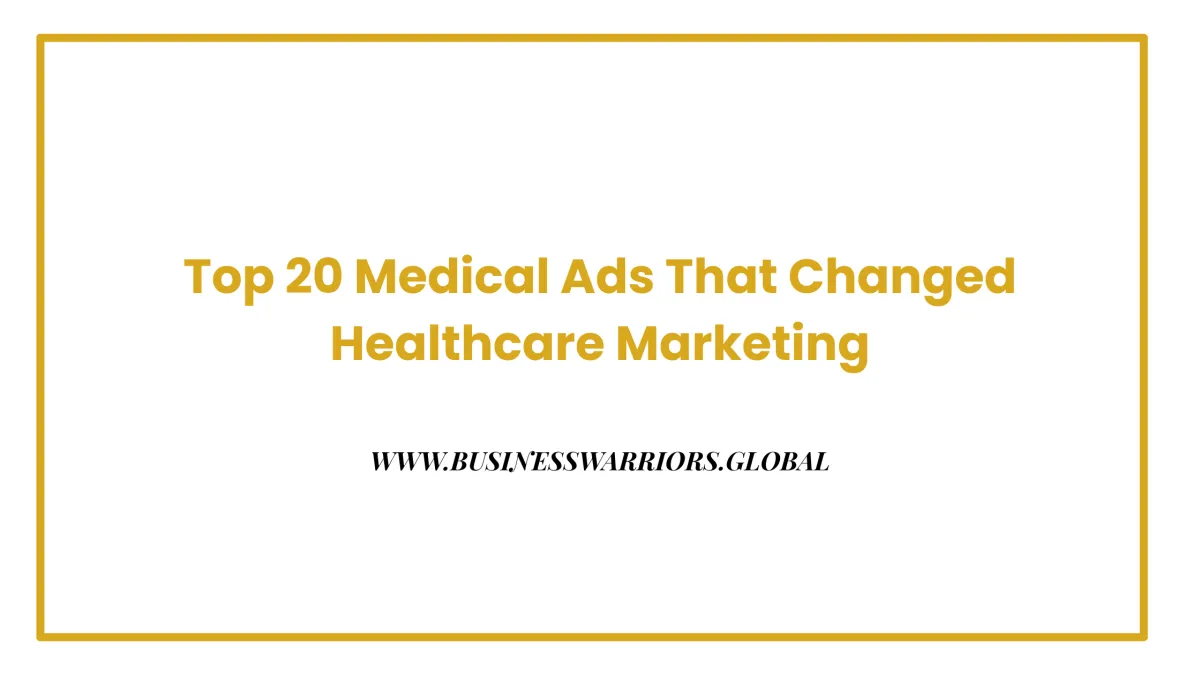
Top 20 Medical Ads That Changed Healthcare Marketing
Interested in how medical ads reshape healthcare? This article showcases 20 groundbreaking campaigns that have redefined healthcare marketing. From empathy-driven ads to those promoting healthier lifestyles, discover the strategies and impacts that made these medical ads stand out.
Introduction to Healthcare Advertising
Healthcare advertising is a cornerstone of the modern healthcare industry, serving as a powerful tool to raise awareness about essential health services, innovative medical devices, and breakthrough pharmaceutical products. Through strategic advertising, healthcare providers, pharmaceutical companies, and medical professionals can inform and educate the public, empowering individuals to make better decisions about their health and wellness. Successful healthcare marketing campaigns not only promote specific services or products but also help improve patient outcomes by encouraging preventive care, early diagnosis, and healthy lifestyle choices. In a competitive industry, effective healthcare advertising drives business growth, builds trust, and positions organizations as leaders in delivering high-quality medical care.
Evolution of Marketing For Healthcare Providers
The landscape of healthcare marketing has transformed dramatically over the past few decades. While traditional media—such as television, radio, and print ads—once dominated the scene, the rise of digital marketing has revolutionized how healthcare companies connect with their audiences. Today, social media channels, websites, and online ads allow healthcare professionals and organizations to reach patients and caregivers more efficiently and interactively than ever before. This digital shift has enabled brands to build awareness, foster engagement, and deliver targeted messages to specific demographics. The evolution of healthcare marketing has also introduced innovative strategies like content marketing, influencer partnerships, and patient-centric campaigns, all designed to resonate with modern consumers and adapt to their changing behaviors and expectations. Evolving regulatory guidelines have also played a key role in shaping how medical ads are created and distributed.
Key Principles of Healthcare Marketing And Online Ads
At the heart of every effective healthcare marketing campaign are several guiding principles that ensure success and compliance. Patient-centricity is paramount—understanding the unique needs, concerns, and preferences of patients, healthcare professionals, and caregivers allows marketers to craft messages that truly resonate. Emotional appeal is another key element, as connecting with audiences on a personal level can inspire trust and motivate action. Transparency and credibility are essential, especially in an industry where trust is critical; healthcare companies must be open about their products, services, and intentions. Additionally, all marketing efforts must adhere to strict regulatory requirements, particularly when promoting medical devices or healthcare services, to maintain ethical standards and protect patient safety. In the United States, FDA regulations set strict standards for medical ads to ensure accuracy and protect patient safety.
Effective Healthcare Ads And Marketing Strategies
In today’s competitive healthcare industry, effective marketing strategies are essential for healthcare providers, pharmaceutical companies, and healthcare organizations aiming to raise awareness and drive positive outcomes. Successful healthcare marketing campaigns blend digital marketing, social media channels, and traditional media to reach a diverse target audience—including patients, caregivers, and healthcare professionals—across various age groups and demographics.
A great example of a modern marketing strategy is leveraging digital platforms to promote healthcare services. Online ads and social media platforms like Facebook, Instagram, and LinkedIn allow healthcare companies to attract attention, build trust, and engage directly with potential patients. These digital marketing efforts can be tailored to specific demographics, ensuring that the right message reaches the right audience at the right time. Additionally, healthcare ads that use real-life scenarios and emotional appeal help create a strong emotional connection, making the message more memorable and impactful.
Traditional media, such as television, radio, and print ads, still play a vital role in healthcare advertising, especially for reaching broader audiences and reinforcing brand presence. Offline advertising, including billboards and community events, can further enhance visibility and credibility within local communities. Combining these approaches ensures that healthcare marketing campaigns are comprehensive and effective.
To stand out, healthcare companies should focus on clear messaging that highlights the benefits of their healthcare services, medical devices, or pharmaceutical products. Detailed information about patient care, waiting time, and positive outcomes can differentiate a healthcare provider from competitors. Incorporating social responsibility and community involvement into marketing efforts not only builds trust but also demonstrates a genuine commitment to improving lives.
High conversions are achieved when healthcare ads are visually appealing, concise, and include a compelling call-to-action. Using data and research to inform marketing strategy allows organizations to measure success, optimize campaigns, and ensure compliance with industry regulations. Collaborating with healthcare professionals and influencers can further enhance credibility and extend reach across social media channels.
Ultimately, the most effective marketing strategies in healthcare are those that prioritize the needs and concerns of the target audience, foster emotional connections, and maintain strict compliance with regulatory standards. By integrating digital marketing, traditional media, and community engagement, healthcare companies can promote awareness, build trust, and establish themselves as leaders in delivering high-quality healthcare services.
Key Takeaways
Cleveland Clinic’s ‘The Power of Empathy’ campaign emphasizes the importance of emotional connections in patient care, enhancing trust and outcomes.
CVS Health’s decision to stop selling tobacco products highlights a commitment to public health, setting a new standard in healthcare marketing.
Dove’s ‘Courage is Beautiful’ campaign honored healthcare workers during the pandemic, showcasing their sacrifices and reinforcing the brand’s commitment to real issues.
Cleveland Clinic – The Power of Empathy With Patient Care
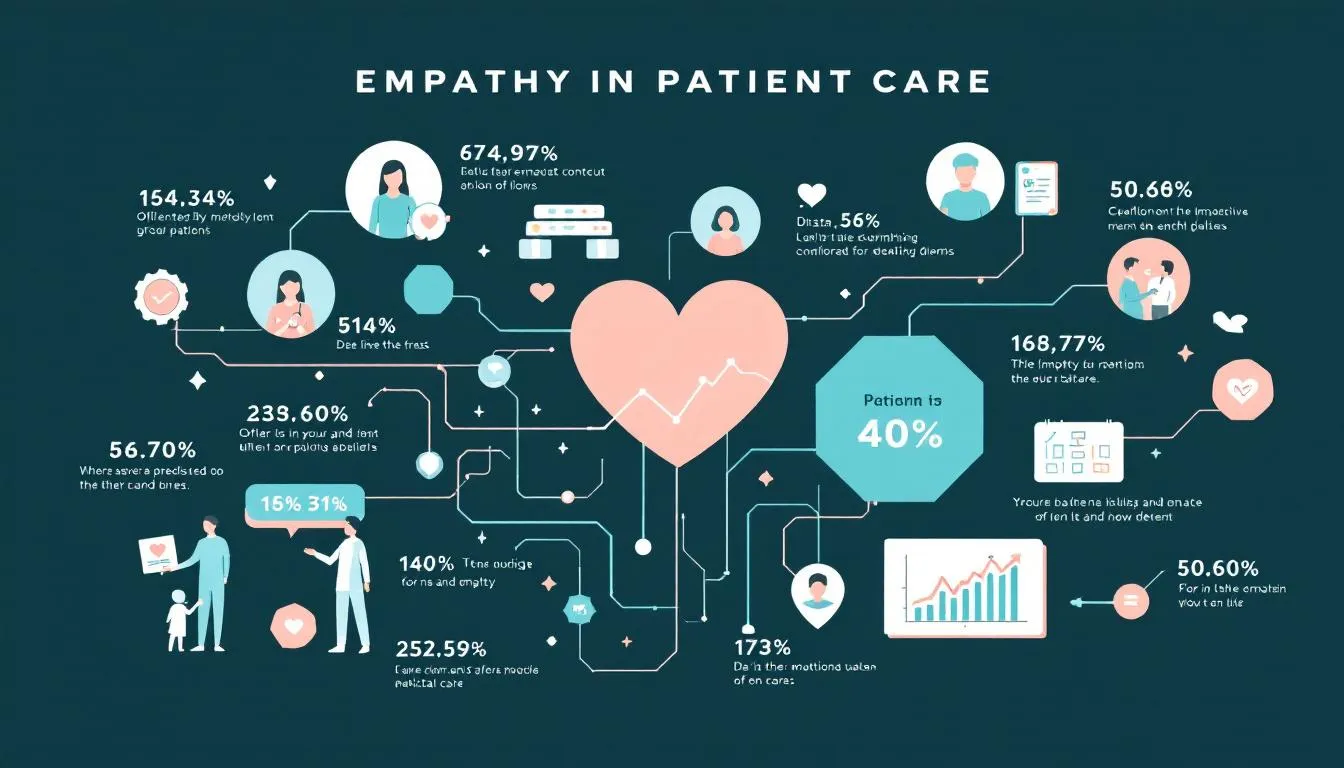
One of the most successful healthcare marketing campaigns, Cleveland Clinic’s “The Power of Empathy,” emphasizes that patient care involves building meaningful connections that go beyond mere medical treatment. The 2013 campaign highlighted empathy as a critical component in enhancing patient experiences and outcomes. Through emotional appeal and real-life scenarios, the ads aimed to inspire healthcare professionals to approach patient care with compassion. By focusing on empathy, the campaign enabled Cleveland Clinic to connect with potential patients, building trust and encouraging them to seek care.
Cleveland Clinic’s advertisements highlighted diverse patient stories, illustrating that everyone has their unique journey, happy or tragic, and that understanding others’ challenges fosters compassion. This focus on empathy helped build trust between patients and healthcare providers, underlining the importance of emotional connection in healthcare.
CVS Health – Breaking the Habit
In 2014, CVS Health made a bold move that caught everyone’s attention: they became the first national pharmacy to stop selling tobacco products. This decision was more than just a business strategy; it was a commitment to public health and a clear message that CVS Health prioritizes the well-being of its customers. The ‘We Quit’ campaign communicated that it’s easier to breathe with full lungs when not smoking, reinforcing the brand’s mission to help people quit smoking.
This healthcare ad campaign not only attract attention but also helped create a healthier environment for all. CVS Health set a new standard in healthcare advertising by aligning their business practices with their health mission, proving that actions speak louder than words.
Doves Emotional Response And Celebrating Healthcare Heroes

During the challenging times of the COVID-19 pandemic, Dove’s ‘Courage is Beautiful’ campaign stood out as a powerful tribute to healthcare providers. The campaign showcased images of carved faces from masks used by healthcare workers, evoking an emotional response nationwide. Dove honored the dedication and sacrifice of healthcare professionals by highlighting the visible effects of their protective gear.
As part of their campaign, Dove donated to the Direct Relief charity, further solidifying their commitment to supporting healthcare services. This successful healthcare marketing campaign not only celebrated healthcare heroes but also reinforced Dove’s brand as one that cares deeply about real people and real issues.
NHS UK – Stay Home, Save Lives
In response to the surge in COVID-19 cases and the significant strain on NHS resources, the UK government launched the ‘Stay Home, Save Lives’ campaign. The campaign also aimed to reduce waiting time for critical care by encouraging people to stay home and prevent overwhelming the healthcare system. With messaging across television, radio, and social media, the campaign’s main message was clear: stay home to protect the NHS and save lives. This effort was crucial as approximately one-third of COVID-19 carriers show no symptoms but can still transmit the virus, making it imperative to follow guidelines.
Featuring Chief Medical Officer Professor Chris Whitty, the campaign also emphasized the importance of vaccination as a pathway to returning to normal life. This comprehensive approach helped convey the critical message and encouraged public compliance during a global crisis.
Pfizer – Science Will Win
Pfizer’s ‘Science Will Win’ campaign was a beacon of hope during the pandemic, emphasizing the pharmaceutical company’s commitment to scientific innovation. As one of the biggest suppliers of COVID-19 vaccines, Pfizer’s efforts in the rapid development and distribution of vaccines were pivotal. The campaign highlighted various scientific achievements, not just in vaccine production but across the board, reinforcing the message that science and technology are key to overcoming global health challenges.
This campaign served to educate the public and assert Pfizer’s role in the industry, showcasing the power of pharmaceutical companies to make a significant impact on global health.
Kaiser Permanente – Thrive Your Way
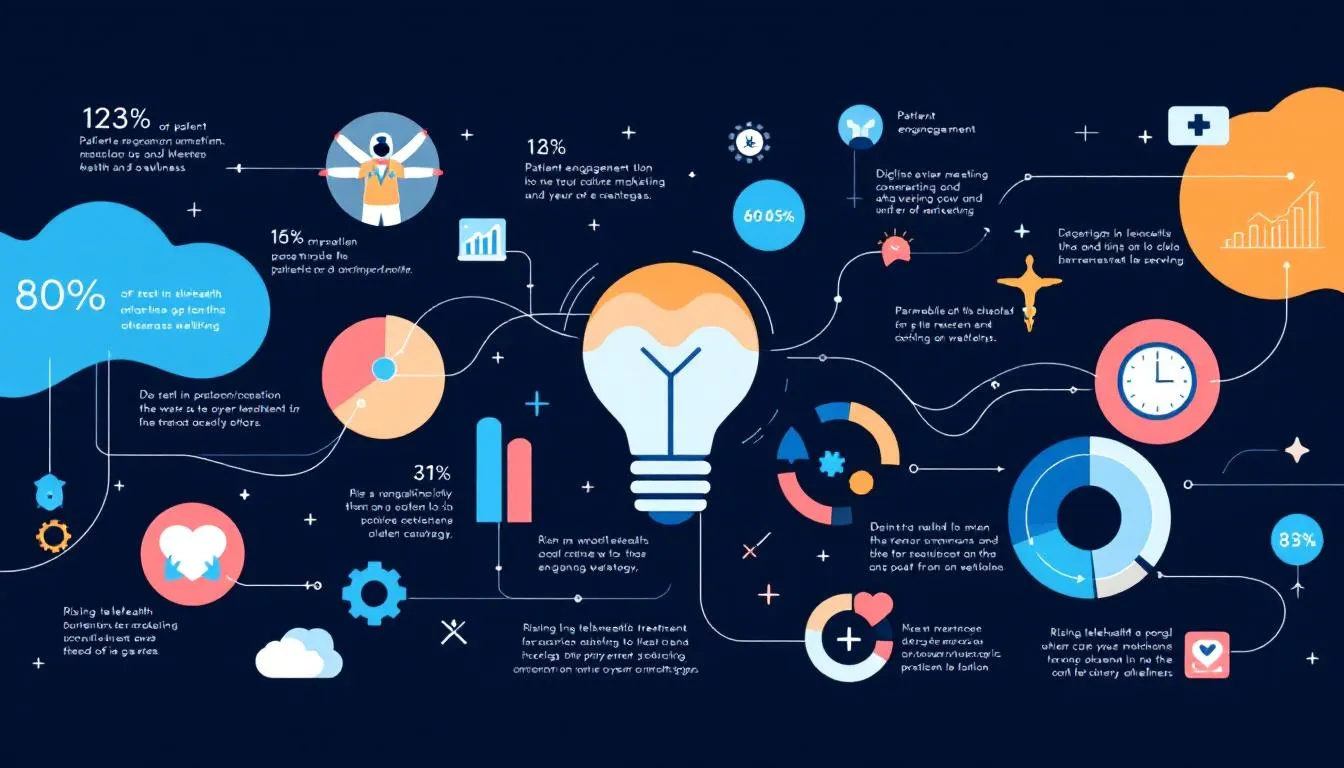
Kaiser Permanente’s ‘Thrive Your Way’ campaign is a great example of successful healthcare marketing campaigns that promote wellness and proactive health management. The ads feature relatable scenarios that highlight the importance of accessing healthcare services both digitally and in person. Kaiser Permanente connected with audiences on a personal level by integrating local elements into their marketing strategy, enhancing the campaign’s effectiveness.
The campaign’s focus on emotional engagement through storytelling resulted in positive outcomes and high conversions, demonstrating the benefits of a well-rounded digital marketing strategy that caters to diverse demographics, marketing efforts, and social media channels. Kaiser Permanente effectively leveraged digital platforms such as their website, social media, and blogs to reach a wider audience, build community, and measure campaign success.
Walgreens – This is Our Shot
Walgreens’ ‘This is Our Shot’ campaign was launched during the COVID-19 pandemic to encourage vaccination. The key message emphasized the importance of getting vaccinated to protect individual health and contribute to community strength. Featuring celebrities like John Legend, the campaign enhanced its visibility and impact, effectively reaching a broad target audience.
This healthcare ad campaign utilized the power of influential figures to spread a critical public health message, demonstrating the effectiveness of leveraging popular culture to advertise in healthcare marketing, healthcare ads, and brands.
Bupa – Is It Normal
Bupa’s ‘Is It Normal’ campaign addresses the common thought of whether one’s feelings and actions are normal, focusing on mental health support. The advertisement features relatable scenarios where individuals express different emotions, reinforcing the idea of shared human experiences. The voiceover poses questions about common feelings, such as anxiety, to validate viewers’ emotions and convey a reassuring message.
Bupa effectively communicated the importance of mental well-being across various age groups by normalizing the act of seeking support for mental health.
St. Jude Children's Research Hospital – Finding Cures, Saving Children
St. Jude Children’s Research Hospital’s mission to provide free care to children battling cancer while actively working to find cures is at the heart of their advertising efforts. The ads share stories of children fighting cancer, showcasing their courage and resilience. St. Jude fosters emotional connections with potential donors by emphasizing authentic narratives about patients, enhancing the impact of their fundraising campaigns.
This approach not only celebrates the journeys of children undergoing cancer treatment but also highlights the organization’s commitment to research and patient care.
St. Jude’s website serves as a central platform for sharing patient stories, providing detailed information about their work, and enabling donors to contribute to their mission.
Cigna – TV Doctors of America

Cigna’s ‘TV Doctors of America’ campaign combines entertainment with a health message, making it more relatable and engaging for viewers. Featuring well-known TV actors portraying doctors, the campaign humorously encourages people to schedule their annual check-ups. With names like Patrick Dempsey and Alan Alda, the TV doctors leverage their popularity to connect with audiences.
While the campaign uses TV doctors for entertainment, Cigna’s healthcare services ultimately connect patients with real doctors, emphasizing authenticity and trust in their healthcare offerings.
Designed to promote preventive healthcare, this campaign underscores the importance of regular medical check-ups and the role of healthcare providers in maintaining overall health within the healthcare organization and the healthcare industry, including essential medical services.
Oscar Health – Health Insurance Made Easy
Targeting a younger, tech-savvy audience, Oscar Health’s ‘Health Insurance Made Easy’ campaign aims to make health insurance feel more personal and less intimidating. The onboarding process is designed to be quick and user-friendly, guiding customers toward suitable plans through straightforward questions.
Oscar’s mobile app enhances customer interaction and brand loyalty by featuring a step tracking system that rewards users for meeting activity goals. The emphasis on telemedicine and price transparency addresses common complaints about unclear billing practices, making healthcare services more accessible and user-friendly.
Planned Parenthood – Breast Health Awareness
Planned Parenthood’s ‘Breast Health Awareness’ ad focuses on educating viewers about breast health through storytelling. By promoting the importance of regular breast checkups, the ad encourages women to prioritize their health. The approach emphasizes education and empowerment over fear, aiming to raise awareness of potential risks and encourage proactive steps in breast health.
This healthcare ad effectively conveys critical messages while empowering women to take charge of their health.
Blue Cross Blue Shield – Live Fearless
The central theme of Blue Cross Blue Shield’s ‘Live Fearless’ campaign is encouraging individuals to live boldly with health insurance support. By promoting a ‘fearless’ mindset, the campaign encourages healthy lifestyle choices and personal ambitions. Utilizing various media platforms, the campaign ensures widespread outreach and engagement.
Emphasizing how health insurance can provide peace of mind, the campaign allows individuals to focus on personal goals without worrying about healthcare costs.
Johnson & Johnson – Champions of Care
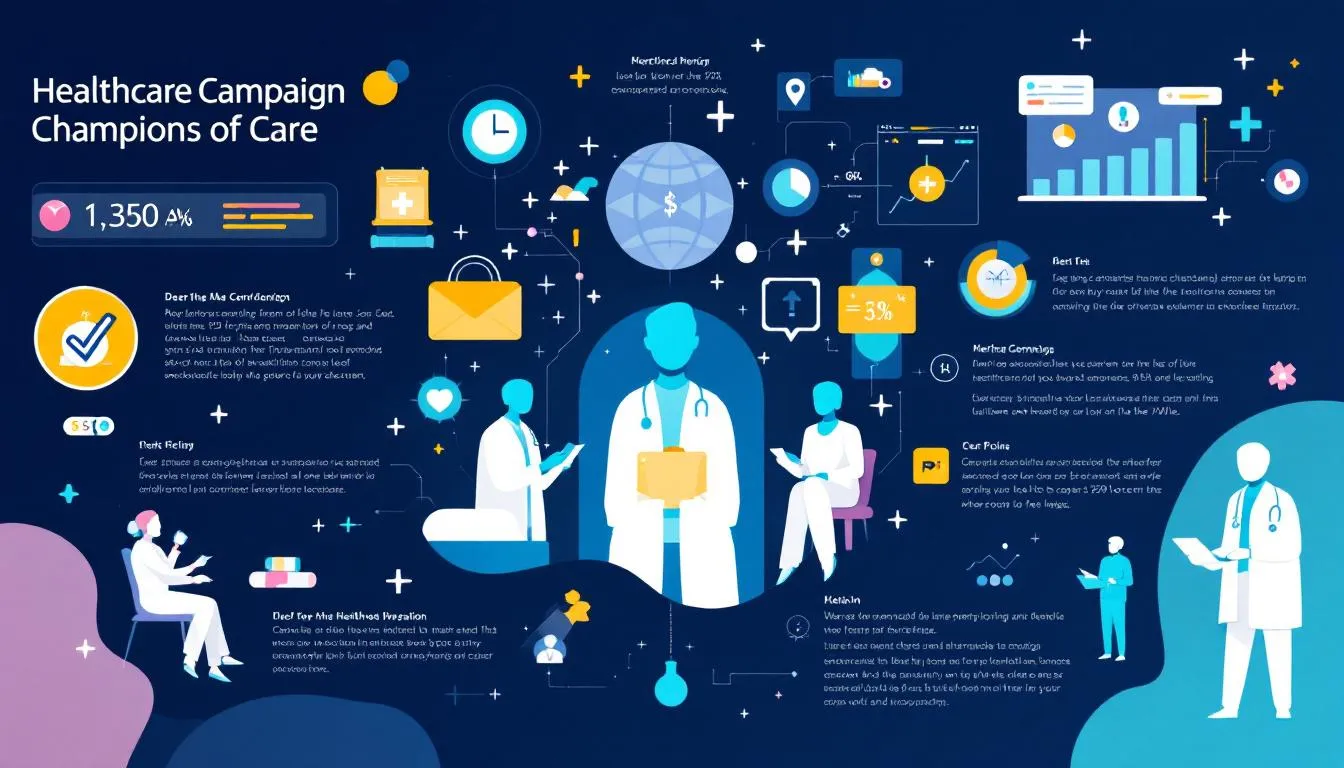
Johnson & Johnson’s ‘Champions of Care’ campaign emphasizes the importance of small acts of kindness in caregiving. By highlighting the significance of compassionate actions, the campaign encourages caregivers to continue their essential work. The ripple effect of kindness promoted by Johnson & Johnson showcases real stories of caregivers and the impact of their kindness within communities.
This campaign demonstrates the power of social responsibility and the role of healthcare companies in promoting positive community values.
Always – Like a Girl
The Always ‘Like a Girl’ campaign challenges stereotypes by redefining the phrase ‘like a girl’ positively. The campaign began with a video that highlighted the negative connotations of the phrase and showcased young girls confidently performing actions like running and throwing.
The campaign successfully turned ‘like a girl’ into a compliment instead of an insult, contributing to a cultural shift and boosting brand awareness and sales while inspiring millions of girls to feel more confident.
Medtronic – Live On. Give On.
Medtronic’s ‘Live On. Give On.’ initiative emphasizes the transformative impact of their treatments on individual lives. The campaign illustrates how their technology enhances patients’ quality of life, showing that patients can live longer and contribute more to society.
Through personal stories of patients who have improved their lives post-treatment, the campaign inspires others and highlights the significant contributions of Medtronic’s medical devices. It also features stories of individuals who have undergone organ transplants, showcasing the positive impact of these procedures and inspiring hope in others facing similar challenges.
Theraflu – Flu Fighter
Theraflu’s ‘Flu Fighter’ campaign uses offline advertising to promote the minimal discomfort and significant health benefits of the flu shot. Positioning the flu shot as a trade-off for complete immunity, the campaign emphasizes the importance of protecting oneself and others. This approach effectively communicates the necessity of flu vaccinations, leveraging ads and online ads to reach a broad audience.
Cancer Research UK – Right Now
Cancer Research UK’s ‘Right Now’ campaign provides a raw and unfiltered look into patients’ lives to raise awareness and support for cancer research. Connecting the audience to the daily struggles faced by cancer patients, the campaign motivates support and emphasizes the urgency of cancer research.
This detailed information helps potential donors understand the impact of their contributions, making the campaign highly relevant and effective.
CareRev – Flexibility for Healthcare Professionals
CareRev’s app promotion highlights authentic storytelling to connect with healthcare professionals on an emotional level. The promotional video portrays CareRev as a solution to burnout, enabling users to regain a healthier work-life balance.
Connecting medical professionals with shifts at local medical facility, the app offers service features that allow healthcare workers to prioritize personal values and prevent burnout.
Celo Health – Secure Communication Platform
Celo Health is a HIPAA-compliant platform designed to enhance communication among care teams, ensuring the privacy of patient information. Utilized by over 500 healthcare organizations, the platform supports real-time communication tools that enhance patient care in various settings.
With flexible messaging solutions and ease of use, Celo Health streamlines communication across different healthcare roles, making it an essential tool in modern healthcare operations.
Online Advertising in Healthcare
Online advertising has become an indispensable part of healthcare marketing, offering unparalleled reach and precision. Healthcare companies leverage online ads to raise awareness about their services, promote new treatments, and drive traffic to their websites. Social media platforms like Facebook, Twitter, and LinkedIn provide powerful tools for targeted advertising, enabling organizations to connect with specific groups—whether patients, healthcare professionals, or caregivers. Programmatic advertising enables healthcare organizations to automate the buying and placement of medical ads, increasing efficiency and targeting precision. These digital campaigns not only increase brand visibility but also foster patient engagement by delivering relevant content and interactive experiences. The measurable nature of online advertising allows healthcare marketers to track results, optimize strategies, and ensure their marketing efforts deliver real benefits to both their organizations and the communities they serve.
The Future of Healthcare Marketing
Looking ahead, the future of healthcare marketing promises even greater innovation and personalization. The integration of digital technologies—such as artificial intelligence, virtual reality, and blockchain—will enable healthcare companies to deliver more tailored and engaging experiences to their target audience. Patient-centricity and personalization will become even more important, as consumers expect marketing that speaks directly to their needs and preferences. To stay ahead, healthcare organizations will need to embrace new strategies like content marketing, influencer collaborations, and account-based marketing, all powered by robust data and analytics. Native advertising will also become more prominent, allowing medical ads to blend seamlessly with editorial content and improve audience engagement. As the industry evolves, transparency, accountability, and compliance with regulatory requirements will remain essential, ensuring that marketing efforts build trust and deliver meaningful value to patients and the broader healthcare community.
Summary
Sum up key points of the article and inspire readers with the impact of these campaigns. Highlight the transformative power of healthcare marketing and its role in improving patient care and public health awareness.
Frequently Asked Questions
Why did CVS Health stop selling tobacco products?
CVS Health ceased selling tobacco products in 2014 to promote public health and align with their mission to support smoking cessation. This decision underscores their commitment to improving community well-being.
What was the main message of the NHS UK's 'Stay Home, Save Lives' campaign?
The main message of the NHS UK's 'Stay Home, Save Lives' campaign was to encourage people to stay home in order to protect the NHS and save lives during the COVID-19 pandemic, highlighting the need to adhere to guidelines and promote vaccination.
How did Dove's 'Courage is Beautiful' campaign support healthcare workers?
Dove's 'Courage is Beautiful' campaign effectively supported healthcare workers by highlighting the impact of protective gear on their faces, while also donating to the Direct Relief charity to enhance healthcare services. This initiative not only raised awareness but also provided tangible support to those on the frontlines.
What is the focus of Medtronic's 'Live On. Give On.' campaign?
Medtronic's 'Live On. Give On.' campaign focuses on the transformative impact of their treatments, highlighting how their technology enhances patients' quality of life and empowers them to contribute more to society.
What role does Celo Health's platform play in healthcare?
Celo Health's platform plays a crucial role in improving communication among care teams while ensuring patient privacy, thereby enhancing collaboration across healthcare settings. This HIPAA-compliant solution fosters a more efficient and cohesive approach to patient care.




